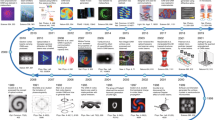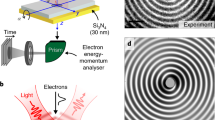Abstract
Vortex beams (also known as beams with a phase singularity) consist of spiralling wavefronts that give rise to angular momentum around the propagation direction. Vortex photon beams are widely used in applications such as optical tweezers to manipulate micrometre-sized particles and in micro-motors to provide angular momentum1,2, improving channel capacity in optical3 and radio-wave4 information transfer, astrophysics5 and so on6. Very recently, an experimental realization of vortex beams formed of electrons was demonstrated7. Here we describe the creation of vortex electron beams, making use of a versatile holographic reconstruction technique in a transmission electron microscope. This technique is a reproducible method of creating vortex electron beams in a conventional electron microscope. We demonstrate how they may be used in electron energy-loss spectroscopy to detect the magnetic state of materials and describe their properties. Our results show that electron vortex beams hold promise for new applications, in particular for analysing and manipulating nanomaterials, and can be easily produced.
This is a preview of subscription content, access via your institution
Access options
Subscribe to this journal
Receive 51 print issues and online access
$199.00 per year
only $3.90 per issue
Buy this article
- Purchase on Springer Link
- Instant access to full article PDF
Prices may be subject to local taxes which are calculated during checkout




Similar content being viewed by others
References
He, H., Friese, M. E. J., Heckenberg, N. R. & Rubinsztein-Dunlop, H. Direct observation of transfer of angular momentum to absorptive particles from a laser beam with a phase singularity. Phys. Rev. Lett. 75 (5) 826–829 (1995)
O'Neill, A. T., Mac Vicar, I., Allen, L. & Padgett, M. J. Intrinsic and extrinsic nature of the orbital angular momentum of a light beam. Phys. Rev. Lett. 88 (5) 053601 (2002)
Barreiro, J. T., Wei, T.-C. & Kwiat, P. G. Beating the channel capacity limit for linear photonic superdense coding. Nature Phys. 4, 282–286 (2008)
Thidé, B. et al. Utilization of photon orbital angular momentum in the low-frequency radio domain. Phys. Rev. Lett. 99, 087701 (2007)
Berkhout, G. C. G. & Beijersbergen, M. W. Using a multipoint interferometer to measure the orbital angular momentum of light in astrophysics. J. Opt. A 11, 094021(7) (2009)
Franke-Arnold, S., Allen, L. & Padgett, M. Advances in optical angular momentum. Laser Photon Rev. 2, 299–313 (2008)
Uchida, M. & Tonomura, A. Generation of electron beams carrying orbital angular momentum. Nature 464, 737–739 (2010)
Beth, R. A. Direct detection of the angular momentum of light. Phys. Rev. 48, 471 (1935)
Allen, L., Beijersbergen, M. W., Spreeuw, R. J. C. & Woerdman, J. P. Orbital angular momentum of light and the transformation of Laguerre-Gaussian laser modes. Phys. Rev. A 45 (11) 8185–8189 (1992)
Cojoc, D. et al. X-ray vortices with high topological charge. Microelectron. Eng. 83, 1360–1363 (2006)
Beijersbergen, M. W. & Allen, L. van der Veen, H. E. L. O. & Woerdman, J. P. Astigmatic laser mode converters and transfer of orbital angular momentum. Opt. Commun. 96, 123–132 (1993)
Bazhenov, V. Y., Vasnetsov, M. V. & Soskin, M. S. Laser beams with screw dislocations in their wavefronts. JETP Lett. 52 (8). 429–431 (1990)
Heckenberg, N. R., McDuff, R., Smith, C. P., Rubinszteindunlop, H. & Wegener, M. J. Laser-beams with phase singularities. Opt. Quantum Electron. 24 (9). S951–S962 (1992)
Nye, J. F. & Berry, M. V. Dislocations in wave trains. Proc. R. Soc. Lond. A 336, 165–190 (1974)
Peele, A. G. et al. Observation of an X-ray vortex. Opt. Lett. 27 (20). 1752–1754 (2002)
Bliokh, K. Y., Bliokh, Y. P., Savel'ev, S. & Nori, F. Semiclassical dynamics of electron wave packets with phase vortices. Phys. Rev. Lett. 99, 190404 (2007)
Schattschneider, P. et al. Detection of magnetic circular dichroism using a transmission electron microscope. Nature 441, 486–488 (2006)
Rubino, S. et al. Energy-loss magnetic chiral dichroism (EMCD): magnetic chiral dichroism in the electron microscope. J. Mater. Res. 23 (10). 2582–2590 (2008)
Schattschneider, P. et al. Real space maps of magnetic moments on the atomic scale: theory and feasibility. Ultramicroscopy 110 (8). 1038–1041 (2010)
Findlay, S. D., Schattschneider, P. & Allen, L. J. Imaging using inelastically scattered electrons in CTEM and STEM geometry. Ultramicroscopy 108 (1). 58–67 (2007)
Babiker, M., Power, W. L. & Allen, L. Light-induced torque on moving atoms. Phys. Rev. Lett. 73, 1239–1242 (1994)
Garcia de Abajo, F. J. Optical excitations in electron microscopy. Rev. Mod. Phys. 82, 209–275 (2010)
Acknowledgements
J.V. acknowledges financial support from the European Union under the Framework 6 programme under a contract for an Integrated Infrastructure Initiative (reference 026019 ESTEEM). H.T. acknowledges the FWO-Vlaanderen for financial support under contract number G.0147.06.
Author information
Authors and Affiliations
Contributions
Author contributions: J.V. developed the idea, designed the apertures, simulated the EELS behaviour, and did first experiments. H.T. did more elaborate experiments and recorded the EELS results. P.S. developed the background of using angular momentum in TEM and EELS and interpreted the results.
Corresponding author
Ethics declarations
Competing interests
The authors declare no competing financial interests.
Supplementary information
Supplementary Figures
This file contains Supplementary Figures 1-3 with legends. (PDF 350 kb)
Rights and permissions
About this article
Cite this article
Verbeeck, J., Tian, H. & Schattschneider, P. Production and application of electron vortex beams. Nature 467, 301–304 (2010). https://doi.org/10.1038/nature09366
Received:
Accepted:
Issue Date:
DOI: https://doi.org/10.1038/nature09366
This article is cited by
-
Free-electron crystals for enhanced X-ray radiation
Light: Science & Applications (2024)
-
Tunable photon-induced spatial modulation of free electrons
Nature Materials (2023)
-
Topologically crafted spatiotemporal vortices in acoustics
Nature Communications (2023)
-
Multi-beam ultrafast laser processing of free-standing nanofilms
Applied Physics A (2023)
-
Tailoring electron beams with high-frequency self-assembled magnetic charged particle micro optics
Nature Communications (2022)
Comments
By submitting a comment you agree to abide by our Terms and Community Guidelines. If you find something abusive or that does not comply with our terms or guidelines please flag it as inappropriate.



